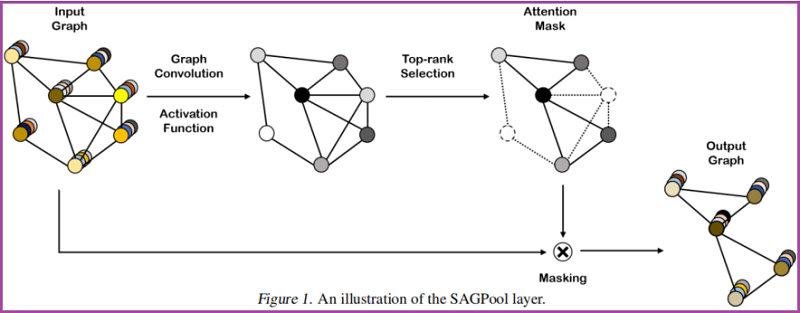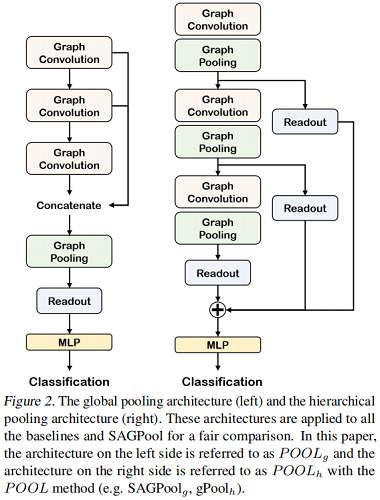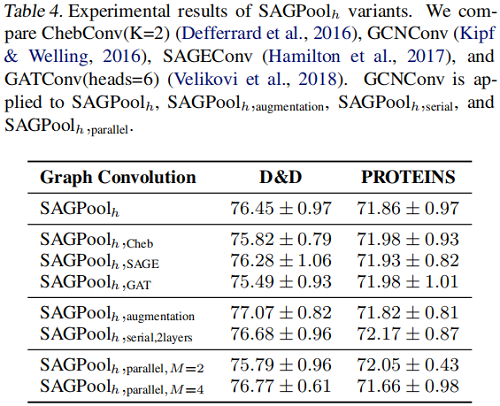论文解读(SAGPool)《Self-Attention Graph Pooling》
论文信息
论文标题:Self-Attention Graph Pooling
论文作者:Junhyun Lee, Inyeop Lee, Jaewoo Kang
论文来源:2019, ICML
论文地址:download
论文代码:download
1 Introduction
图池化三种类型:
- Topology based pooling;
- Hierarchical pooling;(使用所有从 GNN 获得的节点表示)
- Hierarchical pooling;
关于 Hierarchical pooling 聚类分配矩阵:
$\begin{array}{j}S^{(l)}=\operatorname{softmax}\left(\mathrm{GNN}_{l}\left(A^{(l)}, X^{(l)}\right)\right) \\A^{(l+1)}=S^{(l) \top} A^{(l)} S^{(l)}\end{array} \quad\quad\quad\quad(1)$
gPool 取得了与 DiffPool 相当的性能,gPool 需要的存储复杂度为 $\mathcal{O}(|V|+|E|)$,而 DiffPool 需要 $\mathcal{O}\left(k|V|^{2}\right)$,其中 $V$、$E$ 和 $k$ 分别表示顶点、边和池化率。gPool 使用一个可学习的向量 $p$ 来计算投影分数,然后使用这些分数来选择排名靠前的节点。投影得分由 $p$ 与所有节点的特征之间的点积得到。这些分数表示可以保留的节点的信息量。下面的公式大致描述了 gPool 中的池化过程:
$\begin{array}{l} y=X^{(l)} \mathbf{p}^{(l)} /\left\|\mathbf{p}^{(l)}\right\|\\ \mathrm{idx}=\operatorname{top}-\operatorname{rank}(y,\lceil k N\rceil)\\A^{(l+1)}=A_{\mathrm{idx}, \mathrm{idx}}^{(l)}\end{array} \quad\quad\quad\quad(2)$
2 Method
框架如下:

2.1. Self-Attention Graph Pooling
Self-attention mask
本文使用图卷积来获得自注意分数:
$Z=\sigma\left(\tilde{D}^{-\frac{1}{2}} \tilde{A} \tilde{D}^{-\frac{1}{2}} X \Theta_{a t t}\right) \quad\quad\quad\quad(3)$
其中,自注意得分 $Z \in \mathbb{R}^{N \times 1}$、邻接矩阵 $\tilde{A} \in \mathbb{R}^{N \times N}$、注意力参数矩阵 $\Theta_{a t t} \in \mathbb{R}^{F \times 1}$、特征矩阵 $X \in \mathbb{R}^{N \times F}$、度矩阵 $\tilde{D} \in \mathbb{R}^{N \times N}$。
这里考虑节点选择方法,即使输入不同大小和结构的图,也会保留输入图的部分节点。
$\begin{array}{l} \mathrm{idx}=\operatorname{top}-\operatorname{rank}(Z,\lceil k N\rceil)\\Z_{\text {mask }}=Z_{\mathrm{idx}}\end{array} \quad\quad\quad\quad(4)$
基于自注意得分 $Z$ ,选择保留前 $ \lceil k N\rceil$ 个节点,其中 $k \in(0,1]$ 代表着池化率(pooling ratio),$Z_{\text{mask}}$ 是 feature attention mask。。
Graph pooling
接着获得新特征矩阵和邻接矩阵:
$\begin{array}{l} X^{\prime}=X_{\mathrm{idx},:}\\X_{\text {out }}=X^{\prime} \odot Z_{\text {mask }}\\A_{\text {out }}=A_{\mathrm{idx}, \mathrm{idx}}\end{array} \quad\quad\quad\quad(5)$
其中,$\odot$ is the broadcasted elementwise product。
Variation of SAGPool
$Z=\sigma(\operatorname{GNN}(X, A)) \quad\quad\quad\quad(6)$
$Z=\sigma\left(\operatorname{GNN}\left(X, A+A^{2}\right)\right) \quad\quad\quad\quad(7)$
$Z=\sigma\left(\mathrm{GNN}_{2}\left(\sigma\left(\mathrm{GNN}_{1}(X, A)\right), A\right)\right) \quad\quad\quad\quad(8)$
$Z=\frac{1}{M} \sum_{m} \sigma\left(\mathrm{GNN}_{m}(X, A)\right) \quad\quad\quad\quad(9)$
2.2 Model Architecture
本节用来验证模块的有效性。
Convolution layer
图卷积 GCN:
$h^{(l+1)}=\sigma\left(\tilde{D}^{-\frac{1}{2}} \tilde{A} \tilde{D}^{-\frac{1}{2}} h^{(l)} \Theta\right) \quad\quad\quad\quad(10)$
与 $\text{Eq.3}$ 不同的是,$\Theta \in \mathbb{R}^{F \times F^{\prime}}$ 。
Readout layer
根据 JK-net architecture 的思想:
$s=\frac{1}{N} \sum_{i=1}^{N} x_{i} \| \max _{i=1}^{N} x_{i} \quad\quad\quad\quad(11)$
其中:
- $N$ 代表着节点的个数;
- $x_{i}$ 代表着第 $i$ 个节点的特征向量;
Global pooling architecture & Hierarchical pooling architecture
对比如下:

3 Experiments
数据集

基线实验

SAGPool 的变体

4 Conclusion
本文提出了一种基于自注意的SAGPool图池化方法。我们的方法具有以下特征:分层池、同时考虑节点特征和图拓扑、合理的复杂度和端到端表示学习。SAGPool使用一致数量的参数,而不管输入图的大小如何。我们工作的扩展可能包括使用可学习的池化比率来获得每个图的最优聚类大小,并研究每个池化层中多个注意掩模的影响,其中最终的表示可以通过聚合不同的层次表示来获得。
论文解读(SAGPool)《Self-Attention Graph Pooling》的更多相关文章
- 论文解读《Deep Attention-guided Graph Clustering with Dual Self-supervision》
论文信息 论文标题:Deep Attention-guided Graph Clustering with Dual Self-supervision论文作者:Zhihao Peng, Hui Liu ...
- 论文解读GALA《Symmetric Graph Convolutional Autoencoder for Unsupervised Graph Representation Learning》
论文信息 Title:<Symmetric Graph Convolutional Autoencoder for Unsupervised Graph Representation Learn ...
- 论文解读(ChebyGIN)《Understanding Attention and Generalization in Graph Neural Networks》
论文信息 论文标题:Understanding Attention and Generalization in Graph Neural Networks论文作者:Boris Knyazev, Gra ...
- 论文解读(GraphMAE)《GraphMAE: Self-Supervised Masked Graph Autoencoders》
论文信息 论文标题:GraphMAE: Self-Supervised Masked Graph Autoencoders论文作者:Zhenyu Hou, Xiao Liu, Yukuo Cen, Y ...
- 论文解读(KP-GNN)《How Powerful are K-hop Message Passing Graph Neural Networks》
论文信息 论文标题:How Powerful are K-hop Message Passing Graph Neural Networks论文作者:Jiarui Feng, Yixin Chen, ...
- 论文解读(SR-GNN)《Shift-Robust GNNs: Overcoming the Limitations of Localized Graph Training Data》
论文信息 论文标题:Shift-Robust GNNs: Overcoming the Limitations of Localized Graph Training Data论文作者:Qi Zhu, ...
- 论文解读(LG2AR)《Learning Graph Augmentations to Learn Graph Representations》
论文信息 论文标题:Learning Graph Augmentations to Learn Graph Representations论文作者:Kaveh Hassani, Amir Hosein ...
- 论文解读(GCC)《Efficient Graph Convolution for Joint Node RepresentationLearning and Clustering》
论文信息 论文标题:Efficient Graph Convolution for Joint Node RepresentationLearning and Clustering论文作者:Chaki ...
- 论文解读(AGC)《Attributed Graph Clustering via Adaptive Graph Convolution》
论文信息 论文标题:Attributed Graph Clustering via Adaptive Graph Convolution论文作者:Xiaotong Zhang, Han Liu, Qi ...
随机推荐
- 说出几条 Java 中方法重载的最佳实践?
下面有几条可以遵循的方法重载的最佳实践来避免造成自动装箱的混乱. a)不要重载这样的方法:一个方法接收 int 参数,而另个方法接收 Integer 参 数. b)不要重载参数数量一致,而只是参数顺序 ...
- 学习 Haproxy (六)
HAProxy HAProxy是免费 高效 可靠的高可用及负载均衡解决方案,该软件非常适合于处理高负载站点的七层数据请求,HAProxy的工作模式使其可以非常容易且安全地集成到我们现有的站点架构中.使 ...
- 攻防世界 Ditf misc
Ditf 附件下载下来就是一张图片,我们拉到hxd中发现应该有隐藏的压缩包 我们拉入到kali里面分析 意外发现图片高度被修改过我们先用binwalk分析图片看看 我们先尝试分离一下分离出一个压缩包但 ...
- C 语言中 static 的作用
在 C 语言中,static 的字面意思很容易把我们导入歧途,其实它的作用有三条. (1)先来介绍它的第一条也是最重要的一条:隐藏 当我们同时编译多个文件时,所有未加 static 前缀的全局变量和函 ...
- 7_根轨迹_Part1_“根”的作用
这里的渐近线,应该是e^[**wn]/wd,忘记除wd了
- 12 Factor App
The Twelve-Factor App Introduction In the modern era, software is commonly delivered as a service: c ...
- ES6-11学习笔记--解构赋值
解构赋值:按照一定模式,从数组和对象中提取值,对变量进行赋值. 数组解构 对象解构 字符串解构 应用场景 曾经的赋值噩梦,非解构赋值数组: let arr = [1, 2, 3]; let ...
- python-使用函数输出指定范围内Fibonacci数的个数
本题要求实现一个计算Fibonacci数的简单函数,并利用其实现另一个函数,输出两正整数m和n(0<m<n≤100000)之间的所有Fibonacci数的数目. 所谓Fibonacci数列 ...
- android的布局xml文件如何添加注释?
xml布局文件如图添加注释后报错,错误内容如下: 上网查阅xml添加注释的语法规则: XML 中的注释 在 XML 中编写注释的语法与 HTML 的语法很相似: <!--This is a co ...
- SpringMVC注解环境搭建
基本步骤 新建Maven项目(Web) 导入依赖 配置web.xml 配置springmvc配置文件 编写Controller 创建view页面 部署并启动Tomcat 开始搭建 新建Maven项目( ...
